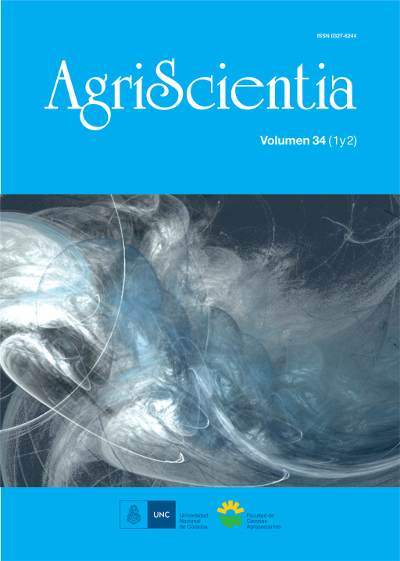Ver ítem
- xmlui.general.dspace_homeCentros Regionales y EEAsCentro Regional CórdobaEEA ManfrediArtículos científicosxmlui.ArtifactBrowser.ItemViewer.trail
- Inicio
- Centros Regionales y EEAs
- Centro Regional Córdoba
- EEA Manfredi
- Artículos científicos
- Ver ítem
Efecto del porcentaje de pildorado sobre la implantación y productividad de alfalfa (Medicago sativa L.)
Resumen
El pildorado consiste en revestir a la semilla de alfalfa con una mezcla de
rizobios, un fungicida o un insecticida, carbonato de calcio y un aglutinante.
El objetivo fue comparar porcentajes de pildorado (10%, 20%, 30%, 50% y
75%) y semilla desnuda, con respecto a la densidad de plantas establecidas
y la producción forrajera. Se implantó un ensayo con tres repeticiones en
otoño de 2013 con una densidad fija (10 kg por ha), y se analizó el número
de
[ver mas...]
El pildorado consiste en revestir a la semilla de alfalfa con una mezcla de
rizobios, un fungicida o un insecticida, carbonato de calcio y un aglutinante.
El objetivo fue comparar porcentajes de pildorado (10%, 20%, 30%, 50% y
75%) y semilla desnuda, con respecto a la densidad de plantas establecidas
y la producción forrajera. Se implantó un ensayo con tres repeticiones en
otoño de 2013 con una densidad fija (10 kg por ha), y se analizó el número
de plantas por m2 a diferentes días de la siembra, y al finalizar la primera
temporada y la producción forrajera. Hasta los 17 y 29 días las plantas por
m2 fueron superiores en los dos tratamientos con semilla desnuda. A partir de
los 46 días, los tratamientos con menor porcentaje de pildorado se ubicaron
entre los mayores valores de plantas por m2. Los niveles altos de pildorado
(30, 50 y 75%) presentaron la menor cantidad de plantas por m2. Las mayores
producciones de forraje se obtuvieron con bajos porcentajes de pildorado y
con semilla desnuda. Las semillas con 75% de pildorado tuvieron el menor
rendimiento acumulado de forraje y uno de los menores valores de número de
plantas por m2 al final de la temporada.
[Cerrar]
Alfalfa seed coating consists of coating the seed with a mixture of rhizobia, a
fungicide or an insecticide, calcium carbonate and a binding substance. The
aim of the study was to compare seed coat percentages (10%, 20%, 30%, 50%
and 75%) and naked seed in relation to established plants and forage yield.
Following a design with 3 reps, a trial was established in 2013 at 10 kg per ha
in which the number of plants per m2 was studied by counting at
[ver mas...]
Alfalfa seed coating consists of coating the seed with a mixture of rhizobia, a
fungicide or an insecticide, calcium carbonate and a binding substance. The
aim of the study was to compare seed coat percentages (10%, 20%, 30%, 50%
and 75%) and naked seed in relation to established plants and forage yield.
Following a design with 3 reps, a trial was established in 2013 at 10 kg per ha
in which the number of plants per m2 was studied by counting at different days
of sowing and at the end of the first season and forage yield. Up to 17 and 29
days after sowing the number of plants per m2 was higher in the two naked
seed treatments. After 46 days of sowing, the treatments with the lowest seed
coating percentage showed the highest numbers of plants per m2. High seed
coating percentages (30%, 50% and 75%) had the lowest number of plants per m2. The highest forage yields were obtained with low seed coating percentages
and naked seed treatments. By contrast, seeds with 75% coating treatment
exhibited the lowest accumulated forage yield and one of the lowest values of
number of plants per m2 at the end of the season.
[Cerrar]

Autor
Fuente
Agriscientia 34 (1) : 59-65. (2017)
Fecha
2017-05-19
ISSN
1668-298X
Formato
pdf
Tipo de documento
artículo
Palabras Claves
Derechos de acceso
Abierto
 Excepto donde se diga explicitamente, este item se publica bajo la siguiente descripción: Creative Commons Attribution-NonCommercial-ShareAlike 2.5 Unported (CC BY-NC-SA 2.5)
Excepto donde se diga explicitamente, este item se publica bajo la siguiente descripción: Creative Commons Attribution-NonCommercial-ShareAlike 2.5 Unported (CC BY-NC-SA 2.5)


